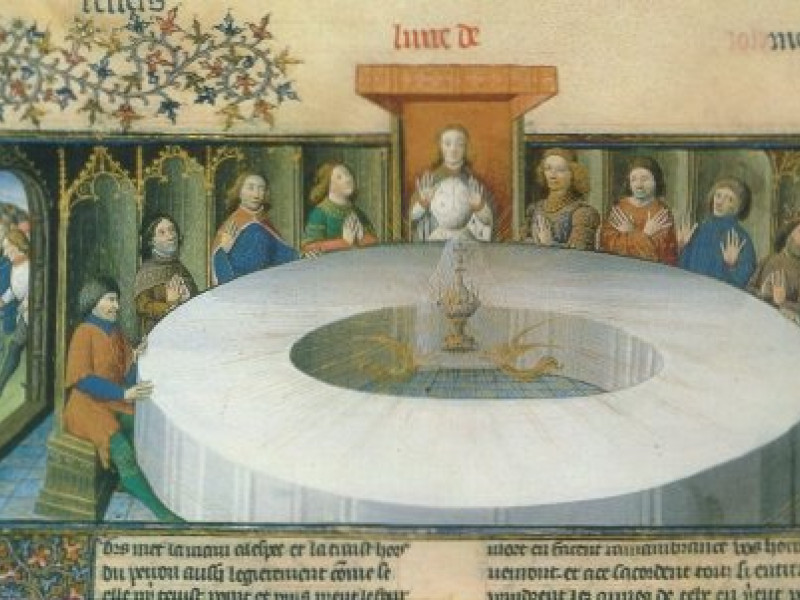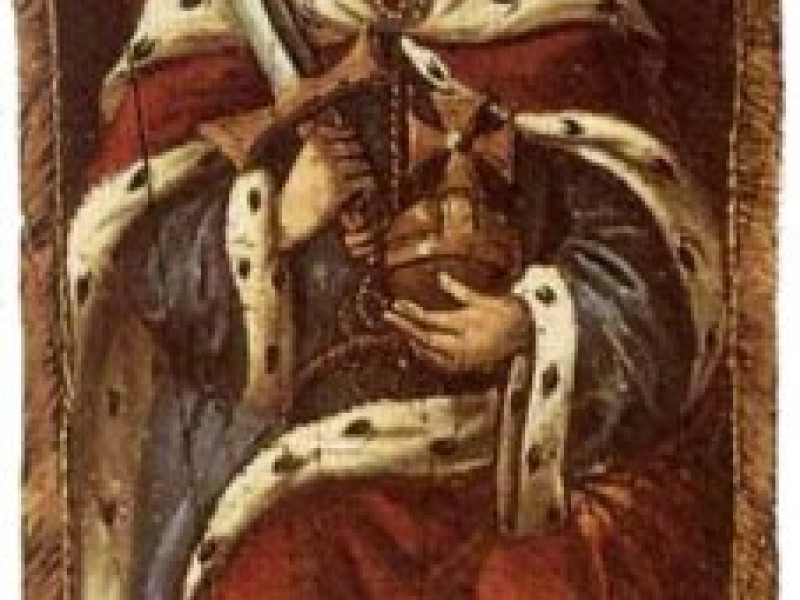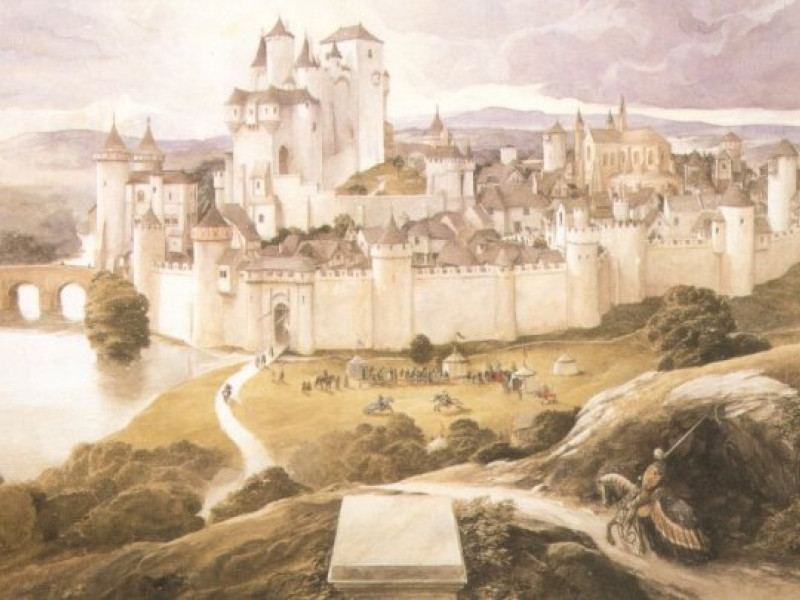Origin of the Round Table
In this section of Arthurian Legends, the Round Table contains information and some stories of the Knights of the Round Table. I would not even think of trying to list all the knights in the Round Table, since each writer gives a different list. However, I will list all the popular knights who figured prominently in the legends.
The most extensive list of names was found in the Post-Vulgate romance of the Grail (78:49-51), which has 110 names out of the 150.
Origin of the Round Table
The fellowship of the Round Table was similar to those of the medieval military orders, Knights Hospitallers (1113) and Knights Templar (1119), founded in the First Crusade. Each order had their own set rules or customs; such as what colour or device they can have on their shields, surcoats, banner, etc.
According to Wace and Layamon
Geoffrey of Monmouth was usually seen as one of the first who brought the Arthurian world to life, though there are earlier scattered works, references and oral traditions from Wales and Brittany. Yet, in his Historia regum Britanniae ("History of the Kings of Britain", c. 1137), a number of essential elements that make up the Arthurian world, didn't appear in his work. The heroes Lancelot and Perceval were nowhere to be seen. There was also no Camelot, no Holy Grail, and more importantly, no Round Table.
It wasn't until 1155, when an Anglo-Norman author from Jersey named Wace, wrote down his Roman de Brut in French and introduced the Round Table into Arthurian legend. However, Wace's version was different from what we popularly know today about the Round Table.
The knights were usually of noble birth: they were usually kings and princes, dukes, counts (or earls) and barons. They formed the backbone of the army, since they were the only ones who could afford expensive armour and weapons, as well as the cost of training and maintaining a war-horse.
When the knights attended a festival or council at the king's main hall, those who sat at the head of the table would usually have precedence over others. These knights would feel envy or jealousy with those of higher ranking. Sometimes, the knights would cause a brawl over who would take the seat at the head of table.
To resolve these problems, Arthur resorted to having his table constructed in a rounded shape. The ingenuity of this design made all the knights equal regardless of whether one were a king versus a minor baron. No one would have precedence over others.
The knights in Arthur's company became known as the "Knights of the Round Table". These knights were heroes, renowned for their strength and courage, and for their skill in combat and warfare. They swore to protect the king and the kingdom.
Layamon, the English author of Brut (c. 1200), who wrote the adaptation of Wace's work, further elaborates the origin of the Round Table.
So the Round Table actually began in a more basic tradition, that of political expediency. There was no magical or mystical ingredient that would appear later in this century or early next century. (See the Life of King Arthur, for the early tradition.)
Note that at this time, there was still no Grail to be sought, nor were there heroes such as Perceval or Galahad.
Boron and the Vulgate Cycle
When the Grail romance became more firmly rooted in the Arthurian legend, the Round Table became directly or indirectly linked with the Grail. The table did not become just furniture to seat Arthur's knights, nor was it to solve a problem of precedence between knights.
Even though the French writer Chretien de Troyes was the first to write about the Grail and the hero Perceval (in c. 1180, titled Conte du Grail), the Round Table was not linked to the Grail at all. It wasn't until around 1200 that Robert de Boron, a French poet, wrote his trilogy, that the Round Table became more entwined with the Grail.
According to Boron and the Vulgate Cycle (1227-1235), the Round Table was devised and created by Merlin, during the reign of Uther Pendragon, father of Arthur.
Merlin used the tables of the Last Supper and of Joseph of Arimathea, as models for the Round Table (See the Origin of the Holy Grail, about Joseph of Arimathea and the Grail Table). The Queste del Saint Graal says that Merlin made the table round, because he wanted it to symbolise the roundness of the Earth.
However, when Uther died, the Round Table was passed on to King Leodegan (Leodegraunce) of Camelide (Camelerd), one of his allies and the father of Guinevere. When Arthur married Guinevere, Leodegan gave the Round Table to Arthur as a wedding gift, along with one hundred knights of Leodegan.
Since the Round Table could seat 150 knights, it was Merlin who helped Arthur to choose the last fifty knights. Each seat (sieges) would have the name of the knight magically written on the back of the seat, in letters of gold. One seat, however, remained unoccupied until the Grail knight appeared. The Archbishop of Canterbury blessed the members who sat around the Round Table.
Though most writers say that the Round Table could seat 150 knights, the number could vary, depending on whose works you were reading. In Perlesvaus (Le Haut Livre du Graal) and Li chevaliers as deus espees (The Knight of Two Swords), there were 366 knights.
The unoccupied seat was known as the Siege Perilous. See Siege Perilous.
Siege Perilous
As the legend evolved and the tales of the Grail became more firmly rooted in the Arthurian legend (in the 13th-14th century), there was only one seat left vacant, and that was the seat that no other knight could sit upon: the "Siege Perilous".
Like the table of Joseph of Arimathea (Grail Table), only one of the seats was left vacated. The Siege Perilous was reserved for the true Grail knight, and would remain unoccupied until the Grail hero appeared. Anyone who sat on it would be killed. Not even Joseph of Arimathea, his brother-in-law Bron, or Alain le Gros, Bron's son, could sit on the Perilous Seat of the Grail Table. Perceval was meant to sit on this perilous seat.
Please note that the Grail Table - which was the table built by Joseph of Arimathea - and the table designed by Merlin, were two different tables. The Grail Table represented the table of spirituality, while the Round Table was for the secular fellowship of Arthurian knights. The Round Table was very much the symbol of Arthur's power, as was his sword Excalibur and his castle abode Camelot.
According to most of the legend, the Grail knight was Perceval, whom the seat was reserved for, until the Vulgate Cycle was composed in 1230. Galahad would then take up Perceval's role as the new Grail knight.
The true Grail hero must be a knight with the purest heart, who was not only chaste, but also a virgin without sins. That knight was Galahad (Perceval according to Boron), the son of Lancelot, the only knight with an understanding of the mystery of the Holy Grail.
Round Table of Many Colours
As I have said before, the Fellowship of the Round Table was very much like the knightly orders of the medieval world of that time.
The military orders began during the First Crusade in 1095 AD, in which the Crusaders attempted to establish hospitals for those serving in the Holy Land (Palestine). They were intended to care for the sick pilgrims and the wounded knights whom fought the Muslims. The first two orders were established in the Holy Land. The Hospitallers of St. John of Jerusalem were commonly known as the Knights Hospitaller (1113) and the Order of the Temple of Solomon became simply known as the Templars (1119). The two orders were later recognised internationally, as well as by the Pope.
Other orders were established, sometimes by rulers. In Germany, the best known order was Teutonic Order (1189-1525). The Teutonic Knights were established during the Third Crusade, but left the Holy Land in 1291, so these knights moved to Hungary, and later invaded and occupied Prussia. In England, during the Hundred Years' War, Edward III established the Order of the Garter in 1348. Around the same time, Philip VI established a rival order to the Garter, known as Chevalier d'Etoil.
These orders wore particular types of surcoats and shield. The Templar wore a white surcoat with a red cross, while the knights of the Teutonic Order wore a white surcoat with a black cross. Some of these orders also had a particular motto or war cry.
Unlike these medieval military orders, Arthur never established any such rules or heraldic designs upon his knights. Each wore knight wore what armour, surcoat or shield they chose. Some knights wore designs upon their shields or surcoats so they could be recognised. Often, a knight would simply wear a solid colour, the most common being white, black, red, green or blue.
In Conte du Graal and other tales about Perceval, Perceval was usually seen as the Red Knight, because the untrained youth had killed a Red Knight that had spilled wine on Queen Guinevere. In the episode of Sir Gareth, in Sir Thomas Malory's Le Morte d'Arthur (1469), Gawain's brother was the White Knight.
The great hero Lancelot wore any armour and shield he was given, due to the fact that he like to travel incognito, so no one would recognise him. Especially when he was on an adventure or participating in a tournament. In the Prose Lancelot (Vulgate Cycle, c. 1227) Lancelot started out being knighted as a White Knight, where the Lady of the Lake provided his armour and weapon, but he changed his armour many times. He was also the Red Knight, the Green Knight, and then the Black Knight. This would often cause trouble for him.
The knights' shields sometimes had depictions of animals, or sometimes a crown or sword. Other times, shields had only one colour or sometimes they had a stripe or two. As I had said, there were no constraints or rules regarding these things in Arthurian legend. According to the 9th century historian Nennius, Arthur carried a shield with an image of the Virgin Mary into battle.
Despite, the lack of uniformity within the fellowship, Arthur and his knights did have a war cry, which they would yell out – "Clarence!".
Imperfect Dreams
Merlin was a prophet and sorcerer who could pierce the past and look into the future. Merlin foresaw the quest for the Grail. Merlin, who was the son of a demon and pious virgin nun, became the champion of the cause for Arthur and the Knights of the Round Table. Merlin saw that the reign of Arthur was the best chance of creating a perfect world.
Merlin used the table of the Last Supper and table of Joseph of Arimathea as the models for the Round Table. The Round Table therefore became a link to the Grail.
The Round Table had further symbolic and mystical meanings. Merlin created the table to resemble the roundness of the world. Merlin dreamed of making a perfect world when he created the Round Table. The Round Table became the symbol of courage and chivalry.
The table was more than a dowry of Guinevere. In a way, Guinevere symbolised the kingdom of Logres (Britain). Arthur, who was Logres' king, was not only wedded to Guinevere; he became wedded to the land. This link between the rulers who were wedded the land was a common theme in Celtic myths.
Though the Round Table represented the world, it was an imperfect world, because the knights were flawed (except for Galahad, who was spiritually perfect). The knights were imperfect and had human failings.
The results of the Quest, when the Grail vanished from the world, also meant the withdrawal of God's grace from Logres. Though the enchantment on Logres was broken and the Maimed King healed, the salvation did not come to the Brotherhood of the Round Table. Instead, they were punished for their failings and their sins.
One of the most notable failings of the Round Table was that of Lancelot, the greatest knight in the world, who was in love with Queen Guinevere. Lancelot and Guinevere committed adultery, and thereby stained the honour of the Round Table. Arthur's war against Lancelot had split the Round Table into two factions, and left him terribly weakened when Mordred betrayed him.
Another failing was Mordred, who also belonged to the Round Table, and was born as the result of incest between Arthur and his half-sister Morgawse. Mordred would allow his own lust for power and his father's wife (Guinevere), to seize the kingdom during Arthur's absence.
Another factor that brought an end to the Round Table was Arthur's pride. Despite a warning in his dream by Gawain, his refusal to ask Lancelot to aid him in the war against Mordred hastened his own doom.
Their sins would bring about the downfall of the Round Table and end the imperfect dreams of Arthur and Merlin.
Related Information
Contents
Related Articles
Arthur, Uther Pendragon, Merlin, Joseph of Arimathea, Guinevere, Lancelot, Perceval, Galahad, Mordred.
Holy Grail.
Round Table (Early Tradition)
Marriage and the Round Table
By Jimmy Joe









